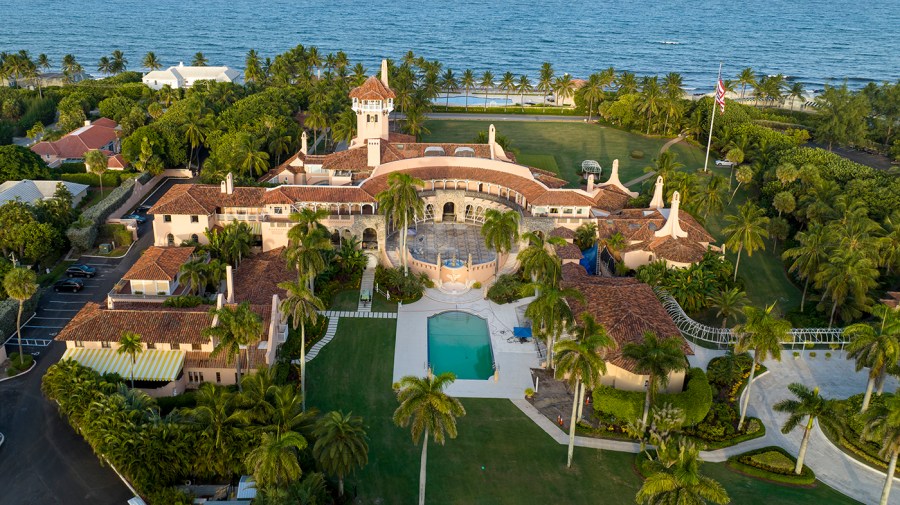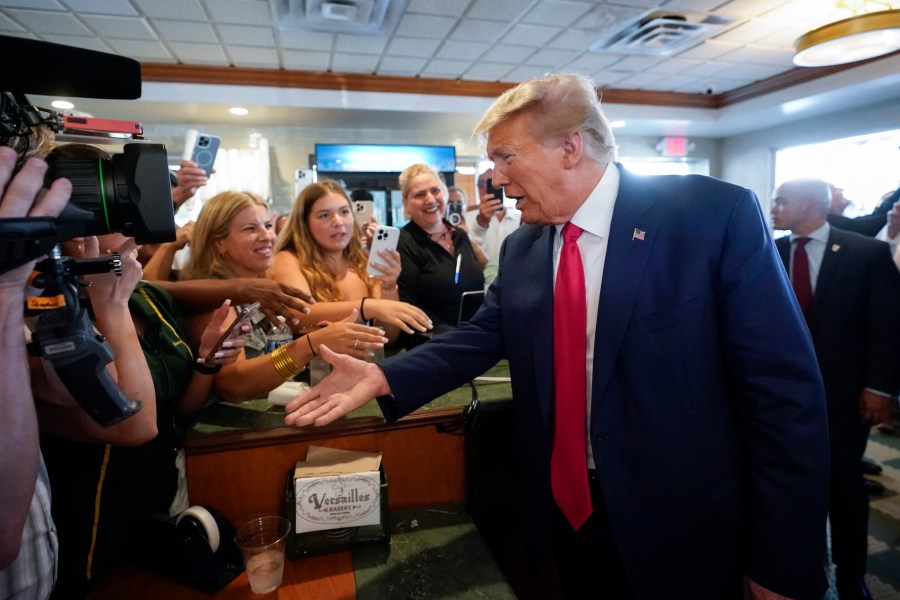Trump indictment lays bare security risks of storage at Mar-a-Lago
Fresh details about how some of the nation’s most closely guarded secrets were handled at former President Trump’s Mar-a-Lago estate have appalled national security experts, who warn the scenario presents serious security risks.
The episode left observers shocked by how sensitive documents were shuffled and stored across the property, even after court filings last year revealed Trump had more than 300 classified records in the Florida home.
Trump’s indictment last week detailed how the documents were at one point kept on the stage of a ballroom, while at other times, the files were stacked high in a Mar-a-Lago bathroom.
“I knew it was going to be bad, but I literally felt sick to my stomach after reading it,” said Larry Pfeiffer, who served as senior director of the White House situation room and chief of staff at the CIA over his career.
“As a guy who’s spent 32 years working to create and produce this intelligence for our national policymakers, it was nauseating to see somebody who served as our commander in chief, as our president, treat this material so recklessly,” he added. “Seeing the photographs of boxes on ballroom stages and in bathrooms next to a toilet and spilled out on the floor because of his carelessness just made me sick.”
More Trump indictment coverage from The Hill
- DOJ seeks protective order to prevent Trump from releasing classified materials amid ongoing investigation
- GOP, Grassley dig for dirt on Biden amid Trump indictment furor
- Scarborough says he thinks Trump kept documents to make deals: ‘This is all about money’
- Chris Wallace says Trump conviction ‘could be a life sentence’
A high-level inventory of the 31 documents the Justice Department is using in the case — just a fraction of those stored at the property — revealed their classification level while offering details about their subject matter and how the information was collected.
The documents include signals intelligence, like intercepted communications or other data, as well as from human sources. Some of the documents contain information about U.S. nuclear programs or military capabilities. Others offer insight into foreign governments, including their military plans.
“That is something that is always alarming to see having made its way outside of a SCIF,” said Tess Bridgeman, who worked as deputy legal adviser to the National Security Council (NSC) in the Obama administration, using an abbreviation for sensitive compartmented information facility.
“When you look at some of the portion markings indicating sensitive signals intelligence and even more so sensitive human intelligence, it’s not just indicating what we know are secrets that are very closely guarded but also how we know it, which raises the concern that it’s not just the information that could be compromised, it’s also sources and methods that could be compromised,” Bridgeman continued.

An aerial view of former President Donald Trump’s Mar-a-Lago estate is seen in 2022 in Palm Beach, Fla. (AP Photo/Steve Helber)
Some of the documents in the trove appear to be special access programs documents, experts said, given the redactions over what are likely the code words required to access them.
“These documents, as I think we feared last year, appear to be what you would expect the president to have, which is some of the most sensitive intelligence or, in some cases, military planning documents that exist,” Pfeiffer said.
“Some of the documents where even the code words are redacted — that’s some pretty sensitive stuff. That is more than likely Special Access Programs that are run by the Pentagon, which, when I was chief of staff of CIA, I didn’t even have access to,” he said. “I mean, that’s some very sensitive, sensitive stuff. So just having this material that would normally be inside locked safes with limited access, inside SCIFs, inside fortified facilities, and here he’s got them stacked up in his shower at Mar-a-Lago — it’s just crazy.”
Some former national security officials said the manner in which the documents were kept was representative of Trump’s broader patterns with national security information while president.
“I found the indictment to be a really vivid picture for the American public of what the national security community dealt with for four years when he was president. He had a blatant disregard, just did not care to follow the rules,” said Elizabeth Neumann, Trump’s assistant secretary for counterterrorism at the Department of Homeland Security, during an appearance on ABC’s “This Week.”
But many Republicans have minimized Trump’s handling of the documents at Mar-a-Lago.
House Speaker Kevin McCarthy (R-Calif.) sought to contrast the episode with the discovery of some classified documents on President Biden’s property, including in his garage, from his tenure as vice president.
McCarthy said while a garage door “opens up all the time,” Trump’s handling of the documents was different because “a bathroom door locks.”
But experts said that is cold comfort given that Mar-a-Lago has long been a target of foreign intelligence outfits, many of which are sophisticated enough to breach a hotel and golf club consistently hosting visitors.
“I guarantee that any foreign intelligence service worth its weight is going to be able to get in and out of a Florida resort hotel and access materials, and you’re never going to know they were ever there. Some people say, ‘Oh, they got cameras.’ Hey, you know, having a camera isn’t going to stop somebody who really knows what they’re doing from getting in and out of a place either,” Pfeiffer said.
A Chinese businesswoman was convicted for trespassing and lying to authorities after pushing her way into Mar-a-Lago while Trump was in office. She was carrying a Faraday bag that blocks electromagnetic signals and multiple cellphones, and a device was found in her hotel room that helps detect hidden cameras.
“So I’m hoping and praying that nobody accessed that material,” Pfeiffer said. “But I am sure there are people inside the intelligence community who were sweating bullets trying to figure out what possibly could have been compromised and what measures maybe need to be taken, or I’m guessing by now have been taken, to mitigate any losses.”
The intelligence community began conducting a damage assessment of the impact of the handling of the documents shortly after the search at Mar-a-Lago.
“Once you know it’s plausible that something was compromised, a decision has to be made essentially whether to treat it as already compromised, whether to cut off those streams of information to protect sources and methods, whether to consider military plans to have been disclosed. So those things I think should not be taken lightly, even if we don’t know for sure that they were disseminated,” Bridgeman said.

Pfeiffer said it’s possible some sources as a result were even exfiltrated — removed from their location for safety reasons but otherwise cutting off a stream of intelligence.
Some of the markings on the documents indicate they may have been shared with the U.S. by allies, including close working partners like the Five Eyes, which includes Australia, Canada, New Zealand and the United Kingdom, in addition to the U.S.
“That is one of the concerns here, that there could be compromised information that didn’t originally come from the United States intelligence community, which obviously would have a chilling effect on whether people want to share with us,” Bridgeman said, a dynamic she noted that could already be underway with Trump’s announced candidacy.
“You can imagine it might have a chilling effect on other countries’ willingness to share important information with us even now,” she said, “if we can’t guarantee that the information will be protected past 2024.”
Trump was charged with 37 counts in connection with the probe, including 31 counts of violating the Espionage Act and others for obstructing justice, concealing documents and making false statements.
As the prosecution gets underway, there remain numerous unanswered questions about the documents, including whether they’ve all been recovered and why the Justice Department chose to focus on these 31.
Pfeiffer pointed to reporting about Trump’s referencing of a document on military planning that he admits he did not declassify, a piece of intelligence CNN reported was never found by Trump’s attorneys.
“It’s not been made clear, in at least the public reporting, whether that document was ever retrieved or not. So it makes you wonder if there are still investigative activities going on to determine if there are more documents available or similar documents that have not been recovered,” he said.
Attorneys have also been speculating about the rationale behind selecting the 31 documents detailed in the indictment, with the inclusion of highly classified records suggesting the Justice Department does not plan to declassify them for the trial.
“One possibility is that these 31 documents are actually the tip of the iceberg that are considered, despite their sensitivity, less sensitive than some others,” Bridgeman said.
Copyright 2023 Nexstar Media Inc. All rights reserved. This material may not be published, broadcast, rewritten, or redistributed.

